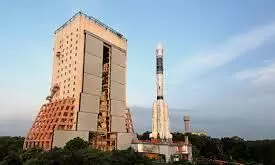
ISRO's ambitions: mega rocket 'Soorya' to take Indians to the Moon
text_fieldsThe Indian Space Research Organisation (ISRO) is aiming high with its future missions, including plans to send humans to the Moon using a new advanced rocket, the Next-Generation Launch Vehicle (NGLV), also known as 'Soorya'.
In an interview with NDTV, ISRO chief S Somanath shared insights about the organization's future projects. Following the success of the Chandrayaan-3 mission, ISRO is now focused on human spaceflight to the Moon. Somanath revealed, "We are developing a new rocket called NGLV or 'Soorya'.
This rocket, currently in the design phase, will feature engines based on Liquid Oxygen (LOx) and Methane for the lower stages and a cryogenic engine for the upper stages."
The 'Soorya' rocket is set to be significantly larger than current ISRO rockets, boasting a payload capacity of over 40 tonnes to Low Earth Orbit (LEO), which is essential for human spaceflight missions. This rocket is expected to facilitate India's Gaganyatri mission, aiming to land Indians on the lunar surface by 2040.
Discussing the Pushpak project, an uncrewed, autonomous, winged reusable launch vehicle, Somanath highlighted the progress made. "We have successfully completed the first phase with a scaled-down version, achieving three successful landings. Now, we are developing a larger version, 1.6 times the size of the initial model, which will be tested similarly with landings and then launched to orbit."
Somanath explained the strategic value of the Pushpak vehicle: "It can transport payloads to orbit and bring them back, making it cost-effective since the payload is often more valuable than the rocket. For deploying satellites, other vehicles like SSLV, PSLV, LMV-3, or GSLV might be more efficient. However, Pushpak's real value lies in its ability to conduct experiments in orbit and return, offering significant benefits."
Regarding India's first space station, Somanath stated, "We are currently in the design phase, with plans to launch the first module by 2028 using the LVM3 (Launch Vehicle Mark-3). The project report and cost estimate have been prepared for government approval."
Initially, the space station will focus on robotic activities. "We will start with robotic operations to build confidence and capabilities for human spaceflight, which we aim to achieve by 2035. Until then, the station will be designed to handle robotic tasks with external mechanisms," he explained.
Somanath also addressed India's potential involvement in international space station efforts. He indicated that, due to resource limitations, India might not participate in replacing the International Space Station if it is decommissioned, stating, "We need to be on equal footing to engage in such global efforts."





